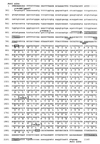Identification by subtractive hybridization of a novel insertion sequence specific for virulent strains of Porphyromonas gingivalis
- PMID: 10531208
- PMCID: PMC96934
- DOI: 10.1128/IAI.67.11.5621-5625.1999
Identification by subtractive hybridization of a novel insertion sequence specific for virulent strains of Porphyromonas gingivalis
Erratum in
- Infect Immun 2000 Sep;68(9):5470
Abstract
Subtractive hybridization was employed to isolate specific genes from virulent Porphyromonas gingivalis strains that are possibly related to abscess formation. The genomic DNA from the virulent strain P. gingivalis W83 was subtracted with DNA from the avirulent strain ATCC 33277. Three clones unique to strain W83 were isolated and sequenced. The cloned DNA fragments were 885, 369, and 132 bp and had slight homology with only Bacillus stearothermophilus IS5377, which is a putative transposase. The regions flanking the cloned DNA fragments were isolated and sequenced, and the gene structure around the clones was revealed. These three clones were located side-by-side in a gene reported as an outer membrane protein. The three clones interrupt the open reading frame of the outer membrane protein gene. This inserted DNA, consisting of three isolated clones, was designated IS1598, which was 1,396 bp (i.e., a 1,158-bp open reading frame) in length and was flanked by 16-bp terminal inverted repeats and a 9-bp duplicated target sequence. IS1598 was detected in P. gingivalis W83, W50, and FDC 381 by Southern hybridization. All three P. gingivalis strains have been shown to possess abscess-forming ability in animal models. However, IS1598 was not detected in avirulent strains of P. gingivalis, including ATCC 33277. The IS1598 may interrupt the synthesis of the outer membrane protein, resulting in changes in the structure of the bacterial outer membrane. The IS1598 isolated in this study is a novel insertion element which might be a specific marker for virulent P. gingivalis strains.
Figures




Similar articles
-
Identification of the genes associated with a virulent strain of Porphyromonas gingivalis using the subtractive hybridization technique.Oral Microbiol Immunol. 2008 Feb;23(1):84-7. doi: 10.1111/j.1399-302X.2007.00396.x. Oral Microbiol Immunol. 2008. PMID: 18173803
-
IS1598 (IsPg4) distributed to abscess-forming strains of Porphyromonas gingivalis may enhance virulence through upregulation of nrdD-like gene expression.New Microbiol. 2018 Jan;41(1):52-60. New Microbiol. 2018. PMID: 29505064
-
[Comparison between genes of highly toxic strain and minimally toxic strain of Porphyromonas gingivalis].Zhonghua Kou Qiang Yi Xue Za Zhi. 2006 Dec;41(12):734-8. Zhonghua Kou Qiang Yi Xue Za Zhi. 2006. PMID: 17349195 Chinese.
-
Genetic diversity of Porphyromonas gingivalis and its possible importance to pathogenicity.Acta Odontol Scand. 2000 Aug;58(4):183-7. doi: 10.1080/000163500429190. Acta Odontol Scand. 2000. PMID: 11045373 Review.
-
Regulation of hemin and iron transport in Porphyromonas gingivalis.Adv Dent Res. 1995 Feb;9(1):41-7. doi: 10.1177/08959374950090010801. Adv Dent Res. 1995. PMID: 7669213 Review.
Cited by
-
Prevalence and Phylogenetic Analysis of Lipoprotein-Gene ragB-1 of Porphyromonas gingivalis-A Pilot Study.Antibiotics (Basel). 2023 Sep 19;12(9):1458. doi: 10.3390/antibiotics12091458. Antibiotics (Basel). 2023. PMID: 37760754 Free PMC article.
-
Modulatory Mechanisms of Pathogenicity in Porphyromonas gingivalis and Other Periodontal Pathobionts.Microorganisms. 2022 Dec 21;11(1):15. doi: 10.3390/microorganisms11010015. Microorganisms. 2022. PMID: 36677306 Free PMC article. Review.
-
Correlation between detection of a plasmid and high-level virulence of Vibrio nigripulchritudo, a pathogen of the shrimp Litopenaeus stylirostris.Appl Environ Microbiol. 2008 May;74(10):3038-47. doi: 10.1128/AEM.02680-07. Epub 2008 Mar 21. Appl Environ Microbiol. 2008. PMID: 18359828 Free PMC article.
-
Distribution of putative virulence genes in Streptococcus mutans strains does not correlate with caries experience.J Clin Microbiol. 2011 Mar;49(3):984-92. doi: 10.1128/JCM.01993-10. Epub 2011 Jan 5. J Clin Microbiol. 2011. PMID: 21209168 Free PMC article.
-
Genetic diversity in the oral pathogen Porphyromonas gingivalis: molecular mechanisms and biological consequences.Future Microbiol. 2013 May;8(5):607-20. doi: 10.2217/fmb.13.30. Future Microbiol. 2013. PMID: 23642116 Free PMC article. Review.
References
-
- Chomczynski P, Sacchi N. Single-step method of RNA isolation by acid guanidinium thiocyanate-phenol-chloroform extraction. Anal Biochem. 1987;162:156–159. - PubMed
-
- Galas D J, Chandler M. Bacterial insertion sequences. In: Berg D E, Howe M M, editors. Mobile DNA. Washington, D.C: American Society for Microbiology; 1989. pp. 109–162.
Publication types
MeSH terms
Substances
Associated data
- Actions
- Actions
- Actions
- Actions
LinkOut - more resources
Full Text Sources
Molecular Biology Databases

